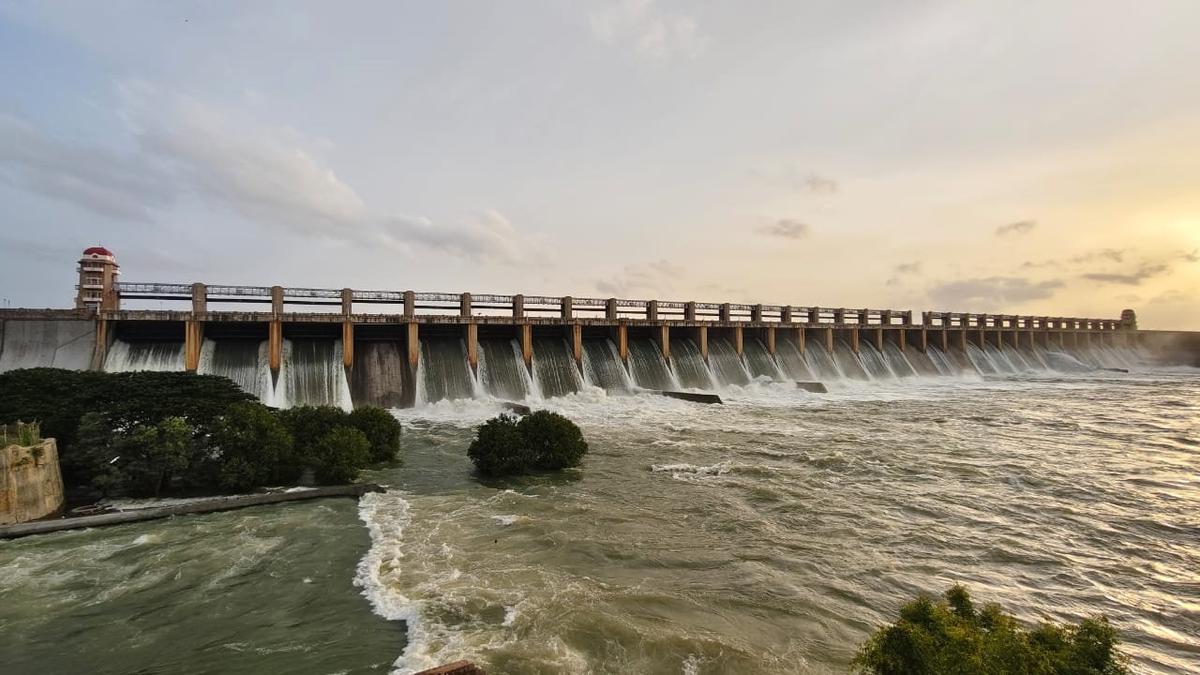Union, State governments blamed as Tungabhadra farmers in Karnataka forced to skip second crop
By Kumar Buradikatti
Copyright thehindu

Lakhs of farmers in the command area of the Tungabhadra reservoir have been forced to forgo the second crop this year, not because of natural drought, but because of faulty crest gates and inaction by the government of Karnataka.
Crest Gates 11, 18, 19, 20, 21, 27 and 28 have been jammed, forcing authorities to restrict the reservoir’s storage to around 80 tmcft (at 1,626.06 feet), against its full capacity of 105.788 tmcft at Full Reservoir Level (FRL) of 1,633 feet, to reduce pressure on the gates.
Minor Irrigation Minister N.S. Boseraju, in the recently concluded Legislative Council session, confirmed the condition of the gates. Deputy Chief Minister and Water Resources Minister D.K. Shivakumar, speaking in the Legislative Assembly, categorically stated that farmers in the Tungabhadra command would not get water for the second crop this year.
Angered by the government’s stand, farmers from Raichur, Koppal and Ballari staged a demonstration outside Tungabhadra Command Area Development Authority office in Munirabad near the dam, accusing both the Union and State governments of ‘lethargy and negligence’ in replacing faulty gates.
“This is not a natural drought but a government-created one. In 2024, when Crest Gate 19 was washed away, experts clearly advised replacing all 33 gates, which have not been overhauled since they were installed 70 years ago. The authorities had one full year, but did nothing. Both Union and State governments are least concerned about the people’s plight,” said Chamarasa Malipatil, senior farmers’ leader from Raichur and honorary president of the Karnataka Rajya Raitha Sangha (KRRS), who led the agitation.
According to Mr. Malipatil, around 8 lakh acres in Koppal, Raichur and Ballari are completely dependent on Tungabhadra waters, and non-availability of irrigation will affect lakhs of people. “The dam irrigates around 14 lakh acres in Karnataka, Andhra Pradesh and Telangana. If water is denied for the second crop, it is not just farmers but also labourers, tractor and harvester operators, and rice mill workers who will suffer,” he said.
The Crest Gate 19 episode
On August 10, 2024, Crest Gate 19 of the Tungabhadra reservoir was washed away when the dam was full, forcing engineers to release water through the other gates to ease pressure. A team led by hydro-mechanical engineer N. Kannaiah Naidu managed to install a temporary five-element stop-log gate fabricated at Hosalli in Koppal district. Though it controlled the outflow, the reservoir had already lost around 36 tmcft in a week, with levels plunging from full capacity to 70 tmcft. Subsequent inflows revived storage and enabled cultivation of the second crop last year.
Experts had then stressed on the urgent need to replace all 33 gates, given the reservoir’s age and lack of overhauling. Karnataka Chief Minister Siddaramaiah, who visited the dam during the crisis, assured support for modernisation but reminded that the Tungabhadra Board, headed by a Union Government appointee and comprising members from Karnataka, Andhra Pradesh and Telangana, bears primary responsibility.
Yet, no comprehensive replacement has begun.
Mr. Boseraju recently admitted that only one new crest gate, weighing 50 tonnes, is ready and will be installed in place of Gate No. 19 after the monsoon.
The silt challenge
Accumulation of a large amount of silt on the dam bed, drastically reducing the reservoir’s storage capacity, is another serious issue that has been crying for attention for several years.
Designed to hold 133 tmcft at FRL of 1,633 feet, it can now store only about 105.788 tmcft – nearly 27 tmcft less than its original design. This shrinkage limits irrigation potential, undermines flood control, and raises concerns about dam safety.
A long-pending proposal to build a balancing reservoir near Navale in Koppal district to offset the silt loss has remained on paper, with the participating States unable to reach a consensus on the project.
Today, with faulty crest gates, reduced storage and official indifference, that lifeline has been disrupted. Farmers in the command area say they feel abandoned at the peak of the agriculture season.
A project with a long legacy
The Tungabhadra Project, first conceived by Sir Arthur Cotton in 1860 to tackle famine in Rayalaseema, became a reality in the 1940s. The foundation stone was laid in 1945, but significant progress came only in 1949 after delays due to technical disagreements and political instability.
By 1953, the masonry was complete, allowing storage and irrigation. The Tungabhadra Board was constituted in the same year to oversee completion and distribution.
After the States Reorganisation Act of 1956, the project became a joint venture of Karnataka and Andhra Pradesh, and later of Karnataka, Andhra Pradesh and Telangana after the bifurcation of Andhra Pradesh in 2014.



